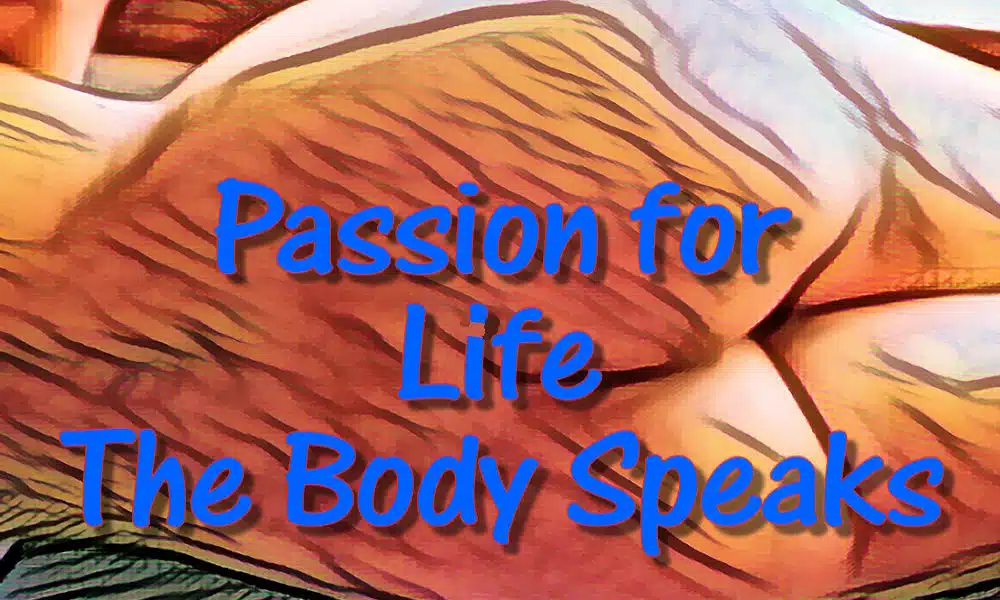Passion for Life—The Body Speaks — we are built in such a way that we ought to see our life’s work—our vocation—as both sacred, and something to be passionate about.

Want to learn more about living a full and meaningful life?
Want to have the best relationship ever?
Check out my books
In the last article, we began to look at the zone of the body connected to passion. I mentioned that the area encompasses the lower belly and the lower back.
This “relationships area” rests upon the firm foundation of the First Chakra—the groundedness chakra.
What’s really important to “get” is the idea that personal, emotional, and relational development requires that you “transcend and include.” In other words, in order to move on, one needs to have mastered each level.
Once you are grounded you have the stability to engage in meaningful and stable relationships.
In this article, we look at passion for life.
Metaphorically, passion for life is located at the lower back—from the waist down, excluding the sciatic nerve pockets (they are a part of the Groundedness region.).
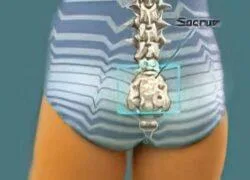
Contained within this region is the sacrum, the triangle-shaped bone that is just above the tailbone. It is not for nothing that the word sacrum derives from the same root as the English word sacred.
We might take from this that we are built in such a way that we ought to see our life’s work—our vocation—as both sacred, and something to be passionate about.
It is to this sense of sacred passion that we turn our attention.
As with everything we write about, it is important to remember that our goal is balance. In this case, balancing is between our understanding and our feelings. Rather than ignore or suppress our feelings, we look to find meaning in what arises.
Here’s a weird thought for you.
In the case of the back pelvic region, the balanced state is full bore passion for life.
Given how emotionally, physically, mentally, and spiritually “dead” most people are,
this seems almost impossible.
Our societies, through socialization, attempt to “normalize us.” It’s even more insidious than that. When you think about it, people who are compliant, docile, and calm—to the point of boring—are also the easiest to manage–and are therefor prized by societies seeking control.
Most people are familiar with Thoreau’s famous quote,
“The mass of men lead lives of quiet desperation. What is called resignation is confirmed desperation.”
Passion scares “society,” and passion scares us. We think of those who have been considered creative geniuses, and part of us thinks that their genius hovered on the edge of madness—think van Gogh, Gauguin, Picasso.
Mostly, when confronted with passion, we’d like to see it dialed back.
What I’m suggesting, and what I’ve seen in Bodywork, is that our passion for life, or perhaps better put, the thermostat for our passion for life, is set way too low. We think “semi-numb” is normal.

I wonder what the world would look like if “normal”
was closer to van Gogh than Elmer Fudd.
Let’s take a moment to talk about balanced Yin and Yang.
The first, and perhaps the most obvious is the left and right sides of the body—the left side is Yin, the right side is Yang.

As regards our topic, passion for life, level hips (as we look at the pelvic region from the back) indicate the perfect balance between Yin intuition and Yang effort.
So, passion for life requires both
- an internal, intuitive, emotional YIN component, and
- a practical, thoughtful, rational YANG component.
Let’s turn to passionate living, vocation, and sacredness.
Passion for life means living your vocation.
Most of us are aware that, at some point in our lives, we had one or more “burning desires.” We remember being “pulled” to excel at something.
Now, if the “thing” we were pulled to was “socially / tribally acceptable,” all was well and good. But in most cases, our yearnings and “burnings” didn’t fit, so our tribes forced us to repress them. Our passions and desires were something our parents / tribes teased us about—and if that didn’t discourage us from stepping out of the norm, some gentle or not so gentle form of repression was applied.
Parents have dreams and aspirations for their kids, and those dreams and aspirations are framed by the lifestyle and culture of the parents.
Most parents freak out when they see the kinds of things that their kids are passionate about—that “turn them on.” So they do what they can to force the kid to fit in. They suggest that the thing that they’re passionate about is just a passing interest, or a hobby. Or they declare it off-limits altogether.
Kids don’t know any better, and actually listen to their parents, so they learn to tighten down and block their passion. From a Bodywork perspective, this involves freezing the pelvis, and tightening the muscles that are just above the pelvis.
The key to overcoming blocked passion for life is twofold: physical, and mental.
The physical side, the Yang aspect, is about loosening the back pelvis through movement, exercise, and Bodywork. The physical side also requires actually doing something with your passion—as with an artist, you have to “put brush to canvas.”
The mental side , the Yin aspect, requires spending time reflecting / meditating. Your “passion-o-meter” is likely set pretty low, and you might have even forgotten what used to turn you on. You’re going to need some time to look inside, and to remember.
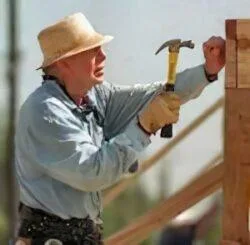
I’m not sure why, but Jimmy Carter keeps popping into my head.
He took a bit of time out to be the president or the USofA, but really, two of his passions are bringing peace, and serving others. Which is sort of the same thing.
If you watch him now, decades and decades years after leaving the presidency, you will see that he’s pretty much on call when it comes to serving his passion.
He’s often out there, swinging a hammer for Habitat for Humanity. And he’s still the “go to guy” for brokering Middle Eastern peace. Despite being retired, if you get the joke.
Here are a few things to try:
1. Bodywork

Naturally. The lower back can be worked on somewhat aggressively, and it’s all about finding tight spots. The key is to apply pressure, on the back, to the top of the pelvis. You’ll likely find sore spots that will yield to pressure.
You can also grip and squeeze the big muscles to either side of the spine, just above where the spine meets the pelvis.
As the tightness relaxes, you’ll feel warmth and the sense of a flow of energy moving up your spine. In Bodywork, getting this energy to flow is paramount.
2. Find a Jesuit!
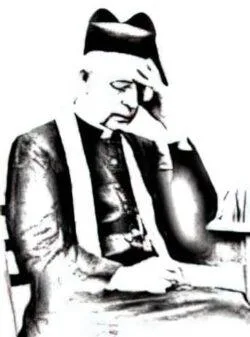
Sort it out!!!
That’s a bit of a joke, but only a bit. The key is to track down someone who can help you explore vocation. Thus, my tongue-in-cheek Jesuit suggestion.
However…
When I was writing my masters thesis, I used to “dig in” by spending a week at a time at a nearby Jesuit Seminary. I wanted the privacy, the solitude, and the quiet to do some serious writing.
But, hey, it was a Jesuit Seminary — and that means there were, wait for it… Jesuits! Everywhere!
And despite a lot of bad press, most Jesuits are pretty smart.
They are used to talking about vocation. They have tools for exploring vocation. One of their vocations is helping people to find their vocations, if you will. Now, of course, their principal direction, in the past, was to find more Jesuits. These days, they spend increasing amount of times with the laity, helping them to explore their vocation — their passion for life.
Failing finding a Jesuit underfoot, you might choke back your incredulity and hire a life coach — but please talk to someone and find someone qualified. I’m big on qualifications, and a six-month online course may just not cut it.
3. Breathe from Your Belly
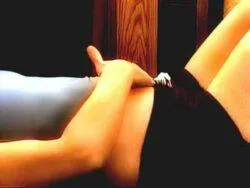
Sure! You want me to practice breathing! Right!
Your Second Chakra (the Lower Dan Tian in Chinese medicine) is located 2 inches below your navel. You want to work at bringing your breath to this place.
The easiest way to learn to do this is to place your hand over the spot, and then breathe deeply, into your belly. The breath should be deep enough to raise, or move, your hand.
Once you have a sense of what that feels like, imagine that your breath is bringing energy to this point. You can play around with the “how.” Imagine the breath coming moving down from your lungs or imagine energy coming up from the ground. Doesn’t matter, so long as the energy ends up, on the in-breath, flooding the Second Chakra region.
On the out-breath, imagine directing the energy. For example,
- Imagine, on the out-breath, sending the energy from your Second Chakra to your hands.
- If you are doing something creative, imagine the energy moving up your spine and flooding your creative centre.
- If you’re with someone who needs support, breathe to your Second Chakra, and then imagine the energy, on the out-breath, flowing up your spine to your heart. From there, imagine the energy flowing into the palms of your hands—in Chinese medicine this point is considered an “out point” for heart energy. And once it’s there, the easiest way to “pass it on” is to give the other person a hug.
Dance
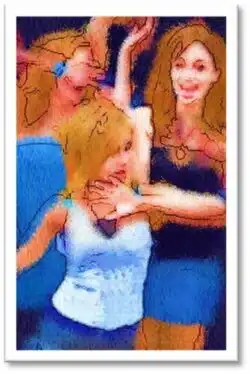
The Second Chakra Region moves in three ways.
- it turns in a circle—think the Hula.
- it rocks side to side—think salsa dancing.
- it tips up and down—use your imagination!
There’s music that is suitable for each of these three things.
The key one is the third one. This motion is so important that we teach it as a part of breathwork—you learn to breathe and then you learn to add a pelvic tilt. So, spend some time moving your pelvis as you dance.
This is a bit of a snapshot of the “passion for life” part of the second chakra region.
Think about creating a masterpiece with everything you do. Continually imagine the fire of passion flowing up your spine. Visualize the sacredness of your life, relax your lower back, and also spend some time moving your pelvis.
I suspect you might be surprised by what emerges.

